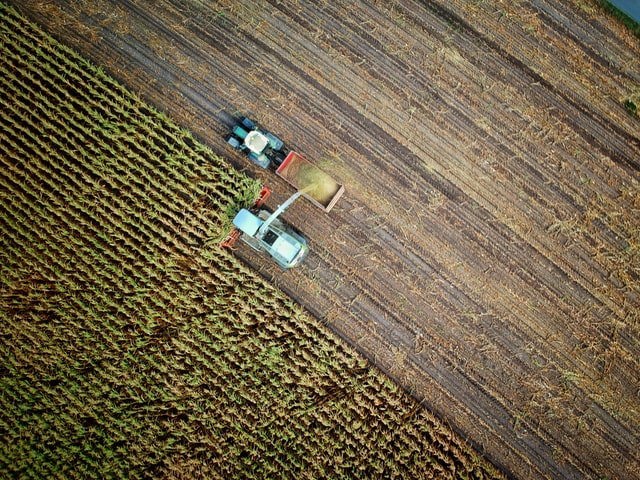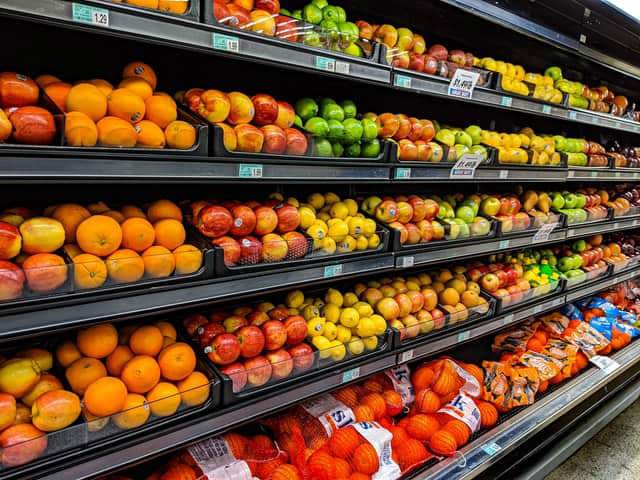
Innovation is a critical factor for food production industry growth.
While the food manufacturing players are experienced innovators, the industry itself is facing new consumer, food safety and regulatory challenges. Technological advances, including innovative food manufacturing software as well as changes in food science, are presenting new opportunities.
However, innovation is needed if industry players are to prosper.
What is the food supply chain?
The food supply chain refers to the process of preparing a food product from start to finish: sourcing the raw materials and taking the food through a manufacturing process, through to the final packaging of the product, the sale to the customer and the final delivery.
Knowing your food supply chain from start to end allows you to address challenges and ensure the supply chain functions effectively and maintain customer satisfaction.
In this article, we’ll explore the ins and outs of the food supply chain, some key challenges and trends for New Zealand, Australia, UK and the US, and how the secret to successful food supply chains lies in food manufacturing software.
How does the food supply chain work?
The food supply chain works the same as any supply chain does, albeit with a more compliance and regulations to ensure food safety standards.
Ben runs a cold-pressed juice company, selling juices to consumers and supermarkets. He buys apples and oranges from farmers, and bottles and labels from another seller — these are his suppliers. Once he processes and bottles the juice, he then sells it to his local grocery store and on his online store.
Depending on the industry and business model, food supply chains differ slightly.
For international businesses, the process can be much more complicated and time-consuming. It can require a team in the receiving country making sure products are delivered to the right warehouse and stored correctly, a dedicated team to oversee customs and more.
Small food manufacturers have a supply chain too — it’s just on a smaller scale. Instead of a dedicated team managing supplier relationships, it might be the procurement manager who manages that as part of their role.
 The food supply chain usually beings with a producer and ends with the end consumer
The food supply chain usually beings with a producer and ends with the end consumer
Food supply chain challenges and issues
Disruptions and delays in the food supply chain can cause problems with sourcing ingredients, processing, packaging, delivery and meeting supply and demand.
Let's take a look what food supply chain challenges plague New Zealand, Australia, the UK and America.
Food supply chain challenges in New Zealand
Lack of communication
When Covid-19 hit, flour disappeared from supermarket shelves — not because New Zealand ran out of flour, but instead it was because suppliers ran out of packaging and couldn’t keep up with the spike in demand.
Ian Proudfoot, global head of agribusiness for KPMG, said that there are over 30 government agencies involved in the food supply chain but piecemeal efforts and siloed conversations are to blame with New Zealand’s food supply chain challenges.
Collecting data in agri-food supply chains
Established New Zealand businesses and tech start-ups are trying to come up with a solution that better manages agricultural data — facts, metrics, and statistics that describe elements of one or more farming or agriculture operations.
Digital data benefits consumers, retailers and processors in the food supply chain by encouraging traceability, enhancing forecasting abilities and supporting product claims.
However, data collectors struggle with:
- Collecting reliable data. Traditionally farmers don’t have a formal way of recording and storing data as it might have been scribbled down on a notepad or never recorded in the first place
- Data quality. Sometimes farmers don’t use the right software or strict validation rules force farmers to “fudge” data to get it accepted by the software
- Sharing data between organisations. Farmers might use one tool and their supply chain partners request that they use another. This can get challenging if producers send goods to different distributors with different needs. Global standards would allow growers and their buyers to use compatible software solutions
Food supply chain challenges in Australia
Cost pressures
In Australia, the supermarket and grocery store industry is highly concentrated, with the four big players making up over 80% of industry revenue.
This means they are able to leverage their market position to command strong agreements with suppliers, which allows them to sell products at low prices that small stores can’t compete with.
Consumers are also highly price-conscious and opt for low-cost supermarkets instead of dairies or small food retailers.
High customer service levels
In this fast-moving, competitive landscape, manufacturers and distributors need to get the right order to the right customers at the right time. Grocery distributors can impose heavy fines for late or missed deliveries or incorrect products as this leads to products being out of stock on shelves.
To this end, manufacturers need to build tolerance for operational disruptions. Distributors need to ensure they aren’t the bottleneck — all while being cost-efficient.
Food supply chain challenges in the UK
Lack of domestic food production
According to a 2020 BBC article, the UK heavily relies on the European Union (EU) for food — about 30% of all the food consumed in the UK comes from the EU. This makes the UK’s food supply chain more vulnerable to disruptions.
Brexit-related challenges
Post-Brexit, UK businesses will trade under the World Trade Organisation rules. This means that businesses will incur higher costs, which will be passed on to domestic consumers or finished exports in the form of higher prices. Experts anticipate that food prices will increase significantly across the UK.
Food supply chain challenges in the US
Growing regulations
Well-intended regulations can inadvertently cause delays within the food supply chain. One recent regulation in America is the ELD mandate. It requires carriers to install an electronic logging device to document the driver’s service hours daily.
This has seen an increase in shipping rates, fewer drivers and therefore a delay in shipping goods — especially fresh and perishable goods.
Food fraud
Food fraud, also known as economically motivated adulteration (EMA), is the intentional sale of food products that aren’t up to recognised standards. Food fraud can lead to damaged brand reputations, impacted revenue, and health complications for consumers.
In 2017, the Grocery Manufacturers Association estimated that a single EMA incident results in an annual revenue loss of 2-15%, depending on the business size. They also estimate that the annual cost of EMA in America is between $10-$15 billion.
 Before food and other produce lands in your shopping cart, it often goes through a long journey on the supply chain
Before food and other produce lands in your shopping cart, it often goes through a long journey on the supply chain
What common challenges do food businesses have?
Regardless of what geographical region food businesses are in, there are some common challenges that the entire food supply chain faces.
Fast-changing consumer habits
Convenience is no longer the main driving force behind purchasing decisions.
Today’s consumers are not bound to purchasing options as dictated by retailers. Thanks to the internet, they are able to access more choice and variety. This resulted in more diversity — from global online retailing to locally sourced, organic products.
Maintaining transparency
Customers today demand more than a label that says 100% organic — they want proof that it’s really the case. In response, fast food joints have started various campaigns explaining their food processes and supply chain in more detail.
McDonald’s ran a campaign called “Our Food. Your Questions.” in 2014 to answer questions about food at McDonald’s because their data suggested that one reason why customers weren’t patronising the outlet was because of food quality misperceptions.
The campaign answered questions such as what McNuggets were made of, are the eggs real, and many more. A year later, they reported a more educated consumer base who were willing to stand by them.
For most fast food retailers, this demand increases complexity and sometimes incurs additional costs. For them to be transparent about the entire supply chain, they would have to implement systems that allow for more visibility throughout the supply chain, both up and downstream.
Or, they would have to be part of the supplier business themselves and manufacture their ingredients.
Waste in the food supply chain
Wasting resources comes down to poor inventory management. Wastage can happen for a variety of reasons. New businesses might order stock without forecasting demand, human error when placing a product order, failure to keep track of best by dates — the list goes on.
The key to avoiding waste in the food supply chain is using food manufacturing software. Most good software comes with features such as batch and serial tracking, stock control capabilities, and forecasting tools.
Transparency and traceability – blockchain technology
Businesses have begun adopting blockchain technology, and it’s been rapidly gaining in popularity among food manufacturers and retailers.
According to research by Gartner, 20% of the top 10 global grocers by revenue will be using blockchain for food safety and traceability to create visibility to production, quality and freshness.
Blockchain technology is a method of ensuring transparency throughout the entire lifecycle of each product as it passes through the food supply chain.
In blockchain technology, the data about each product, including where it was sourced, when, how, and by whom, is recorded in a single shared ledger which cannot be altered once the transaction is logged.
This ensures customers can have confidence that the product they’re purchasing is exactly what it claims to be, and that it underwent processes within the food supply chain that are safe and legal.
Blockchain technology is a great way to lift the standards within a business’ food supply chain – it can reduce the risk of human error because a transaction is only logged once it’s been validated by all relevant parties.
Sustainability in the food supply chain
Just as transparency and traceability are becoming increasingly popular within the food supply chain management world, so is sustainability. Many businesses have acknowledged the demand from consumers to buy food products that have been sustainably sourced and produced, with as little impact on the environment and people as possible.
For example, many companies are improving the sustainability of their food supply chains by recycling waste and packaging materials throughout the food chain from consumer to farm, and by introducing systems that reduce energy consumption, minimise resource inputs and use renewable energy wherever possible.
Summary
Whether it’s a small business just starting out in the world of food manufacturing, or a large multinational food retailer, the food supply chain can pose many challenges. Businesses in the food supply chain can mitigate these problems by ensuring they have the right inventory management software to manage inventory management and to keep abreast of recent trends in food supply chain management, businesses can ensure customer orders are fulfilled efficiently and safely, leading to customer satisfaction, retention, and profitability.
